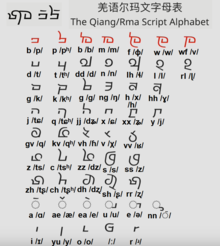Qiang language
You can help expand this article with text translated from the corresponding article in Portuguese. (November 2021) Click [show] for important translation instructions.
|
| Qiang | |
|---|---|
| Ethnicity | Qiang people |
| Geographic distribution | Sichuan Province |
| Linguistic classification | Sino-Tibetan
|
| Subdivisions |
|
| Glottolog | qian1264 |
Qiang language, called Rma (尔玛) or Rme [1] by its speakers, is a Sino-Tibetan language cluster of the Qiangic branch spoken by approximately 140,000 people in north-central Sichuan Province, China.
Qiang consists of:
- Northern Qiang language (a non-tonal language)
- Southern Qiang language (a tonal language)
Writing systems
Qiang Phonetic Alphabet Scheme
There has been two phonetic writing system for Qiang commissioned by PRC authorities, both based on the Latin-script alphabet. The first design was commissioned centrally in 1958 following early PRC work on distinguishing minority ethnic groups in China, but was never officially promoted. The second system, known as the Qiang Phonetic Alphabet Scheme (羌族拼音文字方案; Qiāngzú Pīnyīn Wénzì Fāng'àn) was commissioned by the local government of Ngawa Tibetan and Qiang Autonomous Prefecture and the provincial Ethnic Affairs Commission (EAC) of Sichuan in 1989. Qiang Phonetic Alphabet Scheme uses 26 standard English alphabet letters, and is a standardised form based on the Qugu Qiang dialect, which belongs to the Northern dialect area but roughly situated at linguistic middle point between the two dialects.[2]
Qiang Phonetic Alphabet Scheme was completed in late 1990 and was approved for trial operation by Sichuan provincial government in 1991, in tandem with recommending the Scheme for offical approval by the National Ethnic Affairs Commission (NEAC) in 1991. In 1993, the NEAC requested Chinese Academy of Social Sciences to organise an academic review, which concluded favourably, but NEAC only informed their approval of the Scheme to the provincial EAC by telephone. Qiang Phonetic Alphabet Scheme never ended up being officially published by NEAC or other national authorities thereafter, although the Scheme was acknowledged as legitimate in one written report from NEAC to the central government in 1999. [3]
In 2015, Beichuan Qiang Autonomous County government commissioned a Qiang language graded reader for schools, which uses Qiang Phonetic Alphabet Scheme.[4]
In 2019, a local TV station at Maoxian county started weekly news programme using the Qiang language and the Latin-based alphabet.[5]
Rma script

In 2017, Wei Jiuqiao (魏久乔) finalised their design of the Rma script.[6] There is no published information as to whether the script is compatible with both the Northern Qiang language and the Southern Qiang language or if it is only compatible with one of the languages. A preliminary proposal has been made to encode this system to the Universal Character Set of Unicode.[7]
- Consonants
- Vowels
 a /a/ |
 ae /æ/ |
 ea /e/ |
 u /u/ |
 e /ə/ |
 nn /◌̃/ |
 i /i/ |
 ü /y/ |
 o /o/ |
 /ʔ/ |
 r /ʴ/ |
— |
Classification
Sims (2016)[8] gives the following classification for the "Qiangish" (or "Rma") languages, which include Northern Qiang and Southern Qiang. Individual dialects are highlighted in italics.
- Qiangish
- Northern Qiang ('upstream' *nu- innovation group)
- NW Heishui: Luhua 芦花镇
- Central Heishui
- Qinglang 晴朗乡
- Zhawo 扎窝乡
- Ciba 慈坝乡
- Shuangliusuo 双溜索乡
- uvular V's innovation group: Zhimulin 知木林乡, Hongyan 红岩乡, Mawo 麻窝乡
- SE Heishui: Luoduo 洛多乡, Longba 龙坝乡, Musu 木苏乡, Shidiaolou 石碉楼乡
- North Maoxian: Taiping 太平乡, Songpinggou 松坪沟乡
- South Songpan: Xiaoxing 小姓乡, Zhenjiangguan 镇江关乡, Zhenping 镇坪乡
- West Maoxian / South Heishui: Weigu 维古乡, Waboliangzi 瓦钵乡梁子, Se'ergu 色尔古镇, Ekou, Weicheng 维城乡, Ronghong, Chibusu, Qugu 曲谷乡 [basis for written language], Wadi 洼底乡, Baixi 白溪乡, Huilong 回龙乡, Sanlong 三龙乡
- Central Maoxian: Heihu 黑虎乡
- SE Maoxian (reflexive marker innovation): Goukou 沟口乡, Yonghe 永和乡
- Southern Qiang (perfective agreement suffixes innovation group)
Reconstruction
Sims (2017)[9] reconstructs tones for Proto-Rma (alternatively called Proto-Qiangish), proposing that the lack of tones in Northern Qiang is due to Tibetan influence. High tones and low tones are reconstructed for Proto-Rma, as well as for Proto-Prinmi.
References
- ^ Wen, Maotao (2014). The Creation of the Qiang Ethnicity, its Relation to the Rme People and the Preservation of Rme Language (Master's thesis). Duke University.
- ^ 韦学纯 (2017). 地域社会深描:藏羌彝走廊研究新视角 (in Simplified Chinese). 北京: 社会科学文献出版社. pp. 224–255. ISBN 978-7-5201-0918-5.
- ^ 宝乐日 (2007). 土族、羌族语言及新创文字在学校教育领域使用发展研究 (Ph.D. thesis) (in Simplified Chinese). Minzu University of China. pp. 45–47. doi:10.7666/d.y1050017.
- ^ 汤小均 (2009-05-11). "迄今最系统的《羌族语言文字》读本将进北川校园" (in Simplified Chinese). 成都商报 – via 中新网.
- ^ 茂县融媒体中心 (2019-10-15). "首档羌族母语电视新闻节目《羌语周报》正式开播" (in Simplified Chinese). 阿坝新闻网 – via 搜狐.
- ^ 传承羌语,支持尔玛文 Support the Rma Script of the Qiang (Rma) Language. Archived from the original on 2021-12-21. Retrieved 2019-10-28 – via Youtube.
- ^ Chan, Eiso; Jiuqiao, Wei; Sims, Nathaniel (June 6, 2022). "Preliminary proposal to encode Rma script to UCS" (PDF). Unicode.org. International Organization for Standardization. Retrieved November 13, 2022.
- ^ Sims, Nathaniel (2016). "Towards a More Comprehensive Understanding of Qiang Dialectology" (PDF). Language and Linguistics. 17 (3): 351–381. doi:10.1177/1606822X15586685.
- ^ Sims, Nathaniel (2017). The Suprasegmental Phonology of Proto-Rma (Qiang) in Comparative Perspective. Presented at the 50th International Conference on Sino-Tibetan Languages and Linguistics, Beijing, November 26, 2017.
Bibliography
- Bradley, David (1997). "Tibeto-Burman Languages and Classification" (PDF). In Bradley, D. (ed.). Papers in South East Asian Linguistics No. 14: Tibeto-Burman Languages of the Himalayas. Canberra: Pacific Linguistics. pp. 1–72. ISBN 0-85883-456-1.
- Evans, Jonathan P. (2006). "Vowel Quality in Hongyan Qiang" (PDF). Language and Linguistics. 7 (4): 731–754.
- LaPolla, Randy J. (2003). A Grammar of Qiang: With Annotated Texts and Glossary. with Chenglong Huang. Berlin: Mouton de Gruyter. doi:10.1515/9783110197273. ISBN 3-11-017829-X.









































